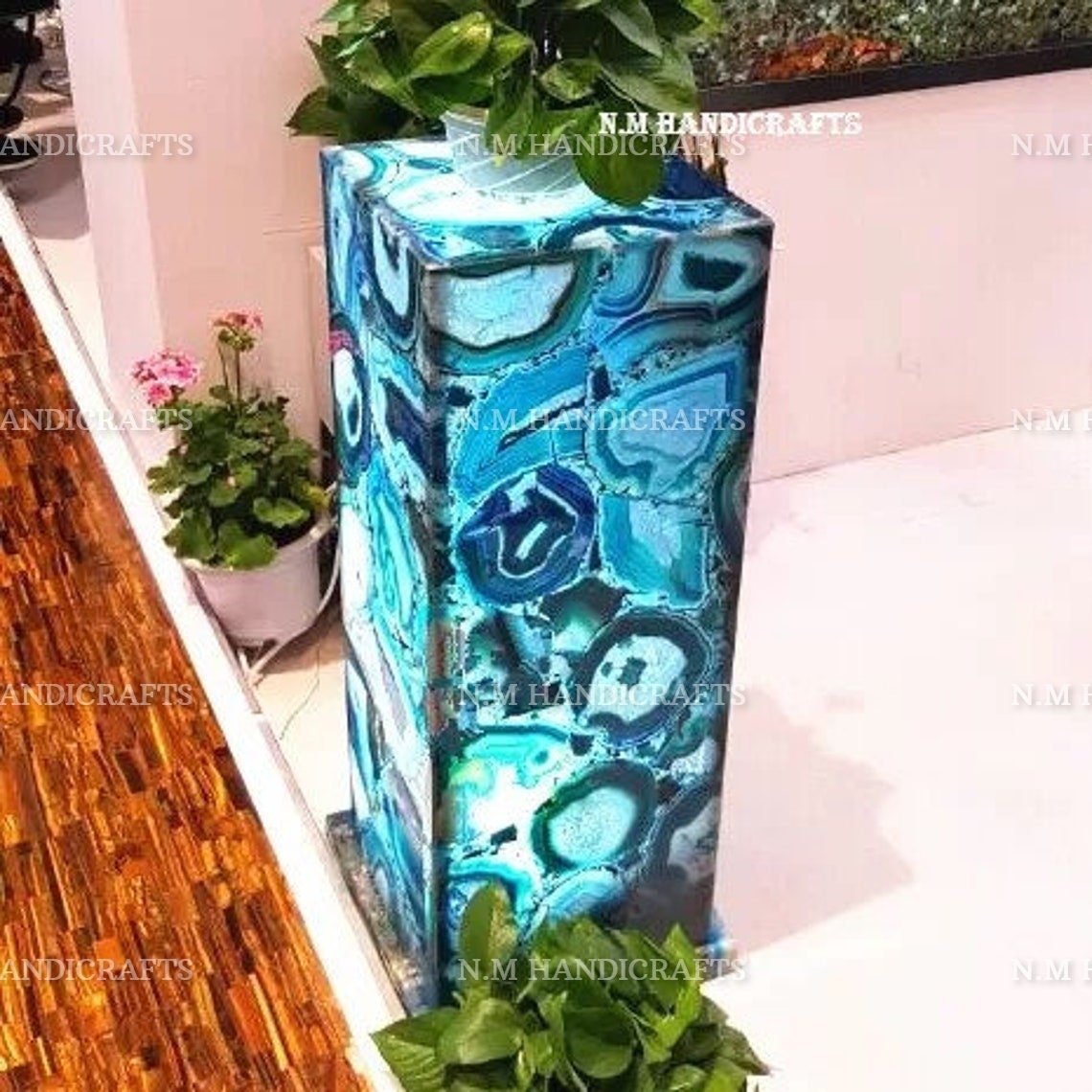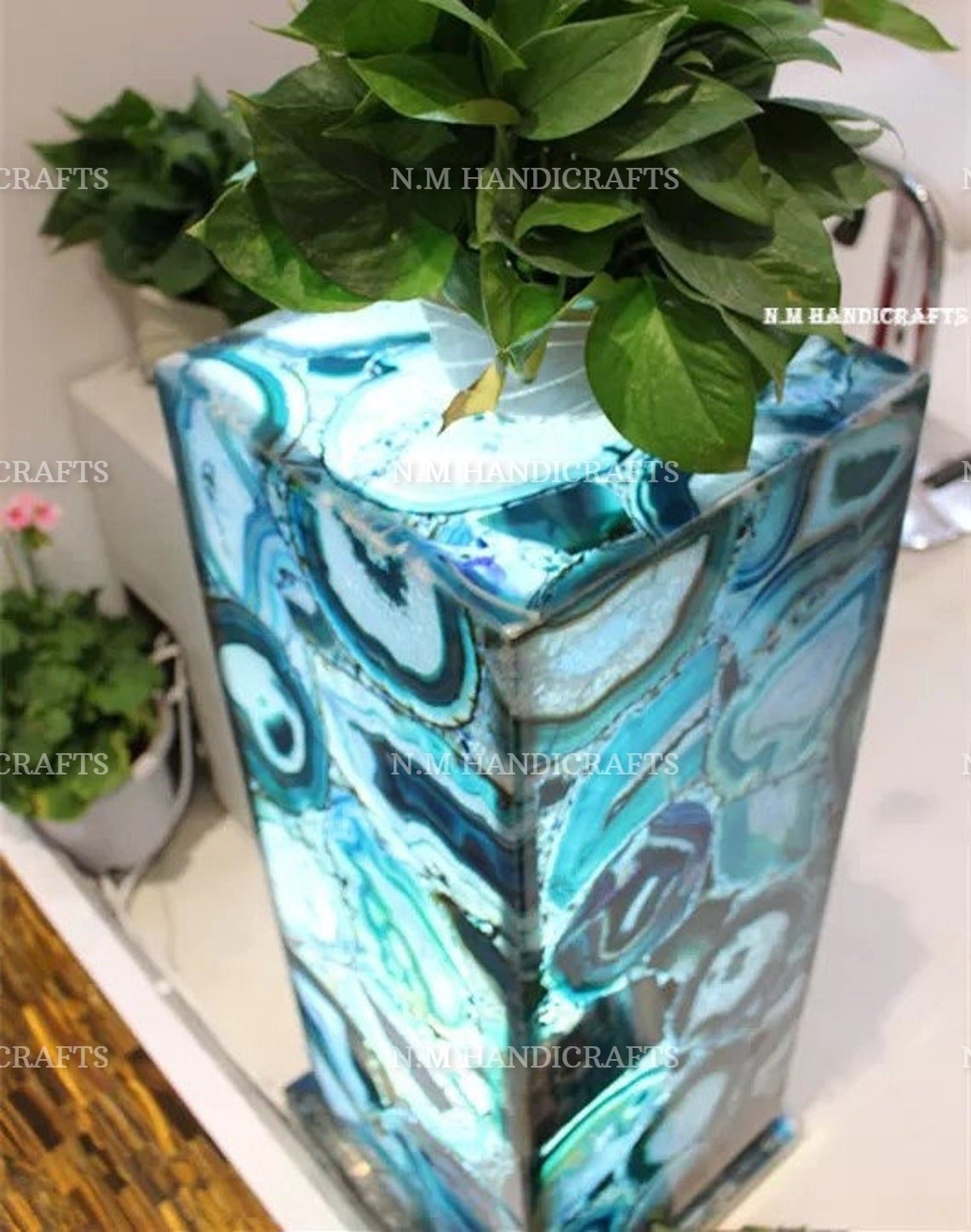Customization Of Size Is Available.
1. This Lamp Does Not Include Any Electronic Parts Like Bulb, Led , Wire, Circuit. This Is Only Lamp Frame.
2. This Product is made in Agra India & fully handmade.
3. The Product will be delivered by FedEx or DHL free of cost door to door.
4. If there is any local tax,custom duties or Vat will be paid by the buyer at the destination.
5. The parcel is dispatch with proper packing & fully insured covering all kind of risk.
6. To maintain this Product is simple soap & water & dry cotton cloth.
7. If You Are Looking Something Customize, Let Us Know We Will Make For You As Per Your Design, Size &
Shape.
8. Agate Have Billions Of Colors. So agate stone may slightly vary from the image shown.
9. We Send A Picture Of The Product For Approval Before Shipping.
Agate Table Tops
We are Manufacturer & Exporter of marble agate table tops. These marble agate table tops have different shapes like Round Table top, Octagonal Table Tops, Rectangle / Dining table tops, Square Table tops, Chess Table tops, Taj Mahal Table tops, Custom Designs Table tops also make marble Table top Base and Stand. Then we can be used as dining tables, coffee tables, Center tables, conference tables, chess boards, reading tables, bar tables , Garden table, side and corner tables or any other use as per the indoor and outdoor decor. They can also be placed outdoors in the garden, as marble is stain free, offers great resistance to the forces of nature, and can withstand heavy temperatures. We also meet customized requirement and offer our marble table tops at industry leading prices.
About Agate Stone-
Agate is a rock consisting primarily of cryptocrystalline silica, chiefly chalcedony, alternating with microgranular quartz. It is characterized by its fineness of grain and variety of color. Although agates may be found in various kinds of host rock, they are classically associated with volcanic rocks and can be common in certain metamorphic rocks.
Ancient use of agate stone
Agate is one of the most common materials used in the art of hardstone carving, and has been recovered at a number of ancient sites, indicating its widespread use in the ancient world; for example, archaeological recovery at the Knossos site on Crete illustrates its role in Bronze Age Minoan culture
Types Of Agate
1. Fortification Agate
This is the most common and distinctive type of agate. In these agates, bands crystallized into
concentric layers that more or less follow the shape of the cavity. The banding resembles an aerial view
of a fort
2. Water-Line Agate (also called water-level or onyx)
During its formation, silica-rich solution either entered the cavity slowly laying one band at a time,
excess water drained out leaving a small amount of silica to settle out into separate bands, or the vesicle
filled under low pressure. In any case, the silica crystallization in water-level agates is controlled by
gravity in one orientation, forming a stack up of parallel bands.
3. Shadow Agate
Some agates exhibit a shadow effect in which there is what appears to be movement across the agate
layers when the specimen is rocked back and forth (or your orientation to the specimen moves). This
optical effect only occurs when there are alternating translucent and opaque bands. It is caused when
light goes into the agate, but is not reflected out.
4. Tube Agate
Tube Agate During the formation of some agates, parallel projections of tiny hair-thin mineral rods grow
first within the silica gel, around which later the chalcedony agate micro-crystals form. In some cases
the inclusions remain, but sometimes they weather away leaving hollow tubes that subsequently fill in
with silica.
5. Eye Agates
This mysterious agate characteristic is believed to be formed when most of the silica gel drains from the
cavity, leaving only a droplet that “beads up” on the inside wall of the cavity. This droplet crystallizes into
solid chalcedony “eyes”. In some cases, crystal growth will continue from this droplet in a manner similar
to the formation of stalactites in caves. Later, the pocket fills in with the usual deposition of chalcedony
microcrystals.
6. Plume Agate
These agates initially had formations on their outside layer that formed prior to the deposition of
chalcedony bands. They are filament growths of mineral inclusions that resemble ferns or feathers.
7. Geode Agate
Geode Agate In some cases the supply of silica-rich water runs out before the entire cavity fills in. When
there is a hollow center within a crystalline outer fill, the specimen is considered a geode. Not all geodes
have agate banding, but many do. Also, the inner layers can form into several different types of silica
mineral crystals and may even have other types of mineral crystals.
8. Moss Agate
Moss Agate Moss agates have clusters of mineral inclusions that resemble plants, trees, or landscapes.
Most moss agate inclusions are comprised of iron or manganese oxide. In some cases, the inclusions
inhibit chalcedony banding allowing the mineral clusters free reign to grow within the silica gel.
9. Seam Agate
Seam agates for in cracks within host rock, rather than in rounder pockets. The bands form in parallel
rows that follow and fill in the crack or seam.
Thanks For Visiting ….Have A Good Day ……








Reviews
There are no reviews yet.